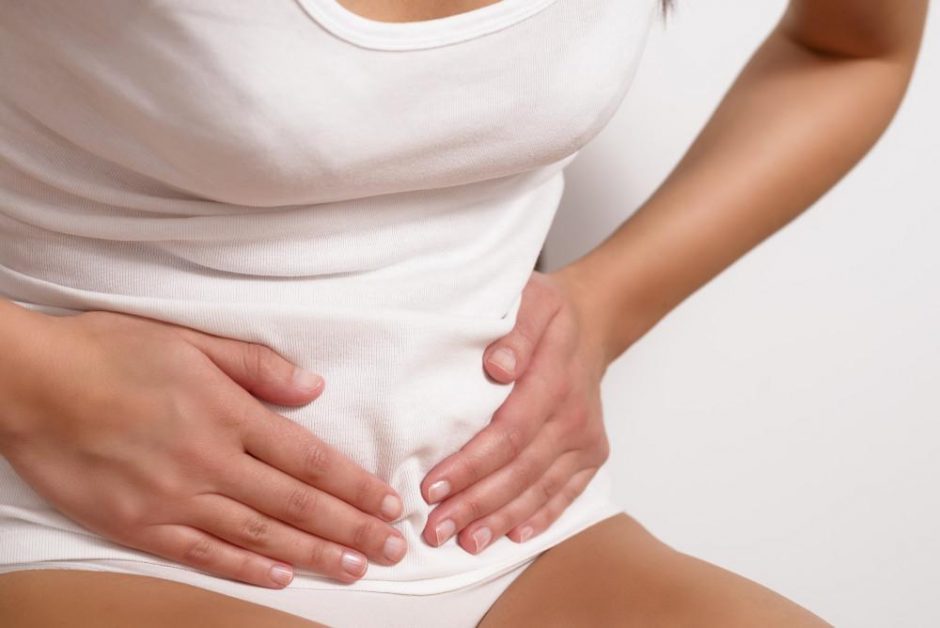The most common cause of pelvic pain in women is an ovarian disorder. The ovaries are paired glands located on both sides of the uterus. They produce female sex hormones that affect the menstrual cycle and the development of secondary sexual characteristics.
Taking into account the rather heavy load, mild pain in the ovaries can be considered normal in most cases. However, severe pain in the right or left part of the pelvis can be a symptom of a serious condition. In this article, we gathered eight common causes of ovary pain you shouldn’t neglect.

1. Ovulation
Some women can experience ovarian pain when they release an egg into the fallopian tube (a process called ovulation). This process usually occurs in the middle of the menstrual cycle. Ovary pain can be different. For someone, it lasts just a few minutes while for others it can stretch for hours. Researchers are still uncertain about the causes of painful ovulation (Mittelschmerz, in German mittelschmerz means “middle pain”). It is assumed that discomfort occurs due to the sensitivity of a particular woman to a follicle rupture. A follicle is a sac which breaks to release the egg.
However, ovary pain during ovulation can have a more dangerous cause. Ovary pain can become a consequence of an infection like chlamydia or gonorrhea. In this case, pain can be accompanied by abnormal discharge and odor. If you have noticed these symptoms, it is better to visit your gynecologist as soon as possible in order to prevent complications.
2. Periods
Pain during periods is called dysmenorrhea. This condition is divided into two types, primary and secondary. Primary dysmenorrhea occurs as a natural response of a body to menstruation. It is completely normal and can be eliminated with the help of a painkiller or heating pad.
Secondary dysmenorrhea is a pain that occurs as a result of an underlying condition that can affect ovaries as well. One of the most common signs of secondary dysmenorrhea is a cramping pain that lasts more than three days. In this case, it is better to visit your gynecologist to undergo proper treatment.
3. Ovarian Cyst
Pelvic pain due to the ovarian cyst can also affect many women. The most common symptoms of ovary cyst include:
• Dull ovary pain
• Irregular periods
• Pain during intercourse or bowel movements
• Regular nausea or vomiting
• Fast saturation
If the cyst is small, it can resolve by itself. But large cysts with a high risk of rupture are surgically removed. Cyst rupture is an extremely dangerous condition that requires emergency help. In this case, hemorrhage in the ovary occurs, which poses a threat to the normal functioning of this organ.

4. PCOS
A complex disease that is sometimes confused with an ovarian cyst is polycystic ovary syndrome. This condition is associated with hormonal imbalance. PCOS causes constant pain that occurs due to the appearance and proliferation of cystic formations in the ovary tissue. The menstrual cycle is also affected by the abnormal functioning of the ovaries, although signs of PMS are present.
PCOS is one of the most common causes of infertility. A woman with PCOS can’t get pregnant even with regular sex proximity. Despite the fact that conservative treatment can ease PCOS symptoms, surgical treatment is considered more effective.
5. Inflammation
Inflammation on the ovaries often occurs as a result of sexually transmitted diseases. However, conditions like autoimmune diseases, endocrine disruptions, or hypothermia can also cause inflammation. The most common signs of ovary inflammation are pain during sex and abnormal vaginal discharge. Ovary inflammation treatment depends on the cause and severity of the condition.
6. Endometriosis
Endometriosis is a condition in which the uterine lining (endometrium) begins to grow outside this uterus. Sometimes it can affect the ovaries. The main problem is that the endometrium is a hormone-sensitive tissue. When menstruation occurs, the uterine lining begins to shed. This results in inflammation and swelling of the ovaries.
Despite the fact that there is no cure for endometriosis, painkillers or hormone replacement therapy can ease its symptoms. However, if the pain is too severe, surgery may be required.
7. Ovarian Hyperstimulation Syndrome
Hyperstimulation syndrome may occur when several follicles mature in the ovaries. It is a common complication during the hormonal treatment of infertility. Hyperstimulation syndrome can lead to cysts, ovarian enlargement, swelling, and weight gain.
Hyperstimulation syndrome treatment requires normalizing the amount of hormones. A severe form of this syndrome is accompanied by shortness of breath, a change in electrolyte balance, kidney failure, and a decrease in blood supply to the ovaries. Such a condition can be normalized only in a hospital.

8. Ovarian Cancer
Ovarian cancer is more common for women after their 60s. The most common symptoms of this condition include pain in the ovaries, discomfort resembling an upset digestive tract, fatigue, and a constant sensation of a foreign object in the pelvis.
It is important to know that more than thirty percent of ovarian cancer cases are lethal. The causes of ovarian cancer are still unknown. In most cases, doctors associate this condition with aging and heredity. In addition, hormonal processes can also contribute to the development of cancer.
Read More:
3 amazing natural remedies to chronic pain
Traveling with back pain: 5 tips for a more comfortable trip
What to do with painful periods in teenagers?
Why do I have chronic stomach pain? 5 potential causes

